So you want to know what’s the best way to promote affiliate links to earn passive income?
The global affiliate marketing industry is worth over $17 billion and it’s expected to grow to a market size of $27.78B by 2027. In the U.S. alone, affiliate marketing spending reached $8.2 billion in 2022, up from 5.4 billion recorded in 2017.
Moreover, did you know that 31% of web publishers say affiliate marketing is their top revenue source?
Based on Google Trends data, search interest for the query “affiliate marketing” has increased steadily over the past few years. Between 2018 and 2023, the search interest is up over 150%.
If you’ve started a blog already, here’s the good news: with 28% of brands teaming up with bloggers to promote their products through affiliate marketing, this party is a financial force to be reckoned with, and you’re invited!
If you are on a quest to uncover the secrets of promoting affiliate links like a pro, you’ve stumbled upon the right guide.
In this article, I’ll walk you through 15 strategies for promoting your affiliate links to grow your commissions. I will also share my best tips and hacks for taking your affiliate game to the next level right away.
Ready to start? Let’s go!
- What is affiliate marketing?
- What is an affiliate link?
- Before you start: 4 crucial affiliate marketing lessons
- 15 best ways to promote affiliate links
- 1. Share affiliate links in your blog posts
- 2. Email your subscribers
- 3. Create a free email course
- 4. Include affiliate links in your video content
- 5. Send Pinterest traffic to your affiliate links
- 6. Share affiliate links on social media
- 7. Create gift guides and product roundups
- 8. Add affiliate links to your digital products
- 9. Set up a resources page
- 10. Share affiliate links in a webinar
- 11. Insert affiliate links to a SlideShare presentation
- 12. Share affiliate links in an online course
- 13. Promote your affiliate site on discussion forums
- 14. Use paid advertising to scale your marketing
- What should you do next? 4 smart affiliate marketing tips
- FAQ: Best way to promote affiliate links
- Final thoughts
Please note: This post contains affiliate links to products I use, trust, and recommend. If you choose to purchase a helpful product using these links, I may receive a small commission for referring you – at no extra cost to you. These funds help me keep this blog up and running.
What is affiliate marketing?
Affiliate marketing is the art of turning your passion, expertise, or online presence into a profitable online business.
It’s a symbiotic relationship between:
- An affiliate marketer (that’s you)
- A business selling products or services
The goal is to introduce potential customers to those businesses and earn a commission when a purchase is made through your unique affiliate link.
In a nutshell, here’s how affiliate marketing works:
- You become a brand ambassador
- You share products or services you genuinely believe in with your audience
- You send potential customers to the business whose products you promote
In return, you receive a percentage of the sales you help generate. It’s a win-win situation for both you and the businesses you promote.
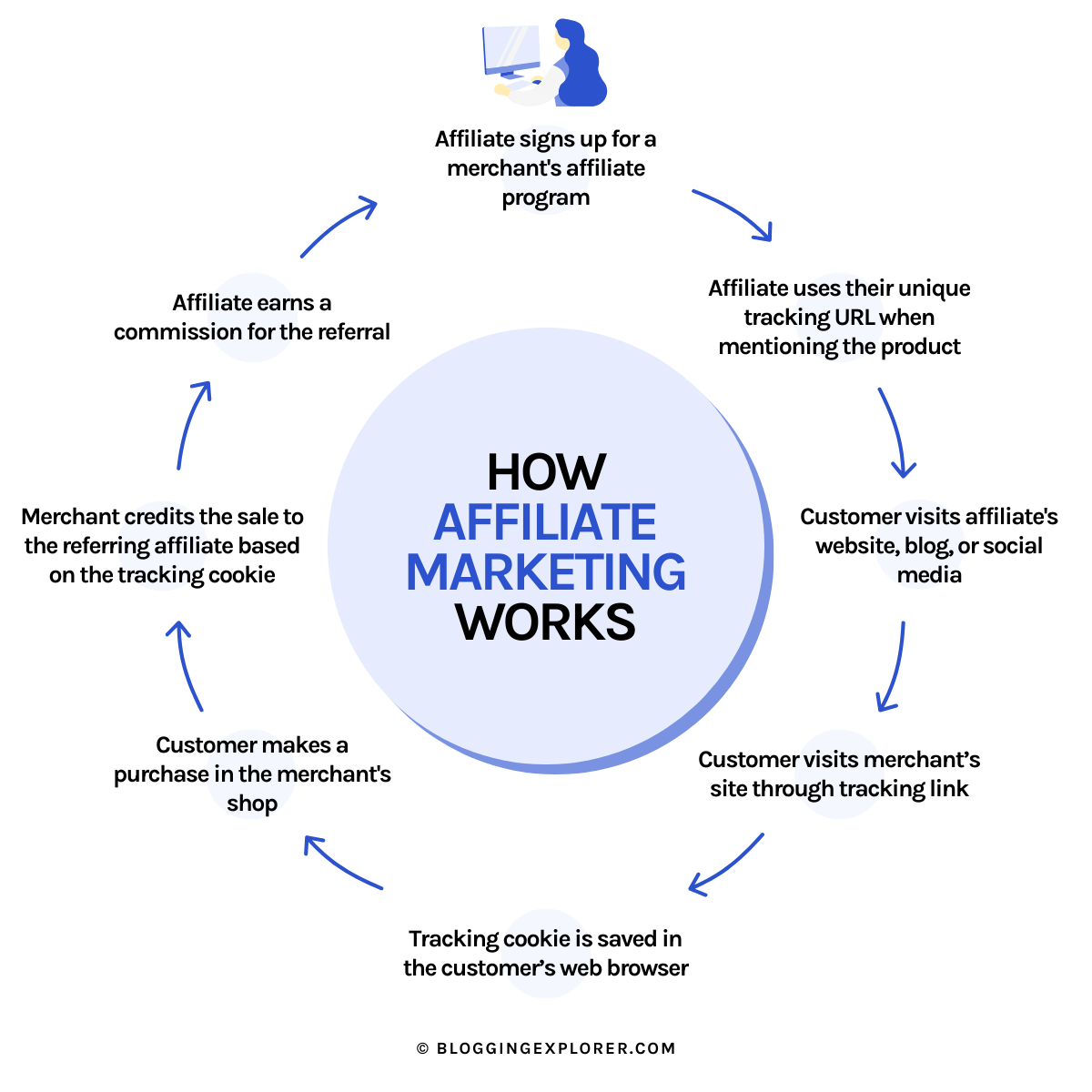
What is an affiliate link?
An affiliate link is a unique URL provided by the affiliate program or network you’ve partnered with. This link is how the business tracks the sales generated through your promotional efforts.
When a visitor clicks on your affiliate link and makes a purchase, the system identifies you as the referring affiliate, and you earn a commission.
These links are the bridges connecting you, your audience, and the products or services you’re promoting.
Before you start: 4 crucial affiliate marketing lessons
To earn money from affiliate marketing, you want to generate as many clicks and commissions as possible.
But being a brand ambassador isn’t just about spamming your affiliate links everywhere you can.
If you are serious about becoming a successful affiliate marketer, you have to educate yourself before you start.
Otherwise, you’ll waste your time on strategies that don’t work.
Think of it like this:
When you see someone share a link to a product, do you click it and make a purchase because the link is there?
Or do you block that person and report them for spamming you?
I’d say the latter is more likely to happen.
Why?
Because we all want to trust the person who’s recommending a product to us. Building trust and connecting with your target audience is absolutely essential when it comes to affiliate marketing.
Hence, steer clear of flooding the web with your affiliate links. Instead, be mindful of why your affiliate product is the perfect match for your audience.
Then, show them how it can make their lives easier. It’s as simple as that.
With that said, here are 4 essential lessons you must learn asap:
1: Know your target audience
Your audience is your compass in affiliate marketing. Understanding their needs, desires, and pain points is your foundation.
If you don’t know what your audience truly needs, how could you deliver them the right type of content?
Earning affiliate income is not about attracting just anyone – it’s about attracting the right people who resonate with your content and recommendations.
Before you start, invest time in researching and defining your target audience so that you can tailor your affiliate strategies accordingly.
2: Provide real value with your content
Content is your superpower. It’s the vehicle through which you connect with your audience, educate them, and make recommendations.
Your content should be informative, engaging, and genuinely helpful. It’s all about presentation.
Be the solution to their problems, answer their questions, and offer insights. When you provide real value, you build trust and credibility.
3: Promote products you use and trust
Authenticity is your ally. It’s essential to promote products or services that you’ve personally used and genuinely believe in.
When your audience senses your sincerity and sees that you’re not just pushing products for the sake of earning a commission, they’re more likely to trust your recommendations.
Of course, it’s up to you to pick the products you promote. But trust me, you don’t want to be that jerk who’s selling products they’ve never tried.
4: Think long-term
Affiliate marketing success is not an overnight achievement. It’s a long-term commitment.
Be prepared to invest time, effort, and dedication into your affiliate marketing journey. Your efforts will compound over time, leading to sustainable income.
Hence, affiliate marketing isn’t a get-rich-quick scheme. Don’t chase quick wins. Instead, focus on building a strong and reputable affiliate marketing business that stands the test of time.
15 best ways to promote affiliate links
With the simple but crucial lessons about affiliate marketing for beginners above, you’re better equipped to embark on your affiliate adventure.
Now, let’s explore the 15 best ways to promote affiliate links and put these lessons into practice.
Save this post for later!
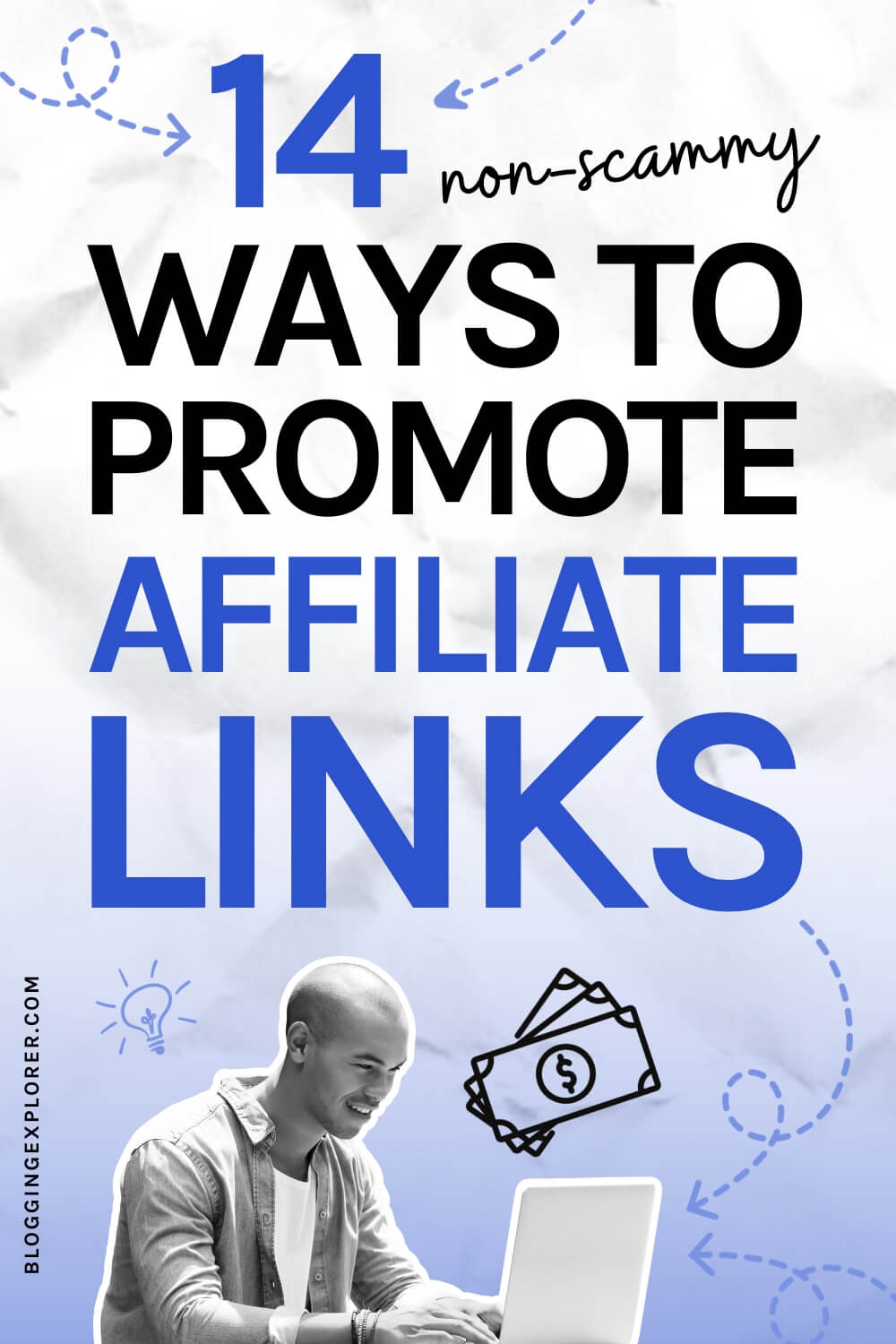
1. Share affiliate links in your blog posts
Imagine having a digital treasure chest at your disposal, with every word you write adding to your affiliate income. High-quality content is your golden ticket to this treasure.
Once you’ve started a blog, you have the perfect platform for publishing valuable content that solves your readers’ problems right away.
As long as you publish top-notch blog posts that address your readers pain points, you’ll build a loyal readership who are interested in what you have to say.
Step-by-step, your blog traffic will grow as more people discover your content. And that, my fellow blogger, is when your hard work will pay off.
Quality content establishes you as the guru in your niche, guiding your audience toward wise choices. Treat your blog like a business, follow a consistent content strategy, and avoid blogging overwhelm to stay focussed and motivated.
Practical example:
Picture this: you’re in the fitness niche, and you’ve penned an epic guide on weight loss for busy people. It’s a masterclass blog post in healthy living with time-saving tips for getting real results faster.
If you’ve tried and tested an online excercise subscription service, showcase the results you’ve ahieved and share your affiliate link to that specific resource.
Hence, promoting your affiliate links in blog posts is all about serving your readers the perfect product for their needs on a silver platter.
Quick tips:
- Dive deep into keyword research to understand what your audience is craving.
- Create content that’s not just informative but visually appealing, like a treasure map to riches.
- Seamlessly integrate affiliate links, so they feel like the next logical step.
- Don’t forget to revisit and update your content at regular intervals.
2. Email your subscribers
With 4 billion people using email daily and 50% of people buying from marketing emails at least once per month, the money is in the list. Your email list, that is.
Why?
Because your email list isn’t just a list. It’s your direct channel to your audience, and the most powerful way you can build trust with your readers and create your own online community of engaged readers.
Remember: when someone subscribes to your email list, they’re already loving your content. Hence, they want to stay in touch and are interested in your content.
If you haven’t already, start your email list right now.
Next, set up an automated email sequence where you share targeted, valuable insights to your subscribers.
For example, create a free 5-day email course:
- Deliver one email per day, educating your list about a specific topic.
- Offer real value and share your personal experience with your affiliate product.
- Make sure your readers understand how that product has made your life easier.
Also, remember to create a two-way discussion by asking your subscribers to reply to your emails. Use their valuable feedback to improve your content even further.
Here’s what you should do:
Create a free account with MailerLite. Create an optin form and embed it on your blog so that your readers can join your list. Send out a weekly newsletter to your subscribers, peppered with handpicked affiliate product recommendations tailored to their needs.
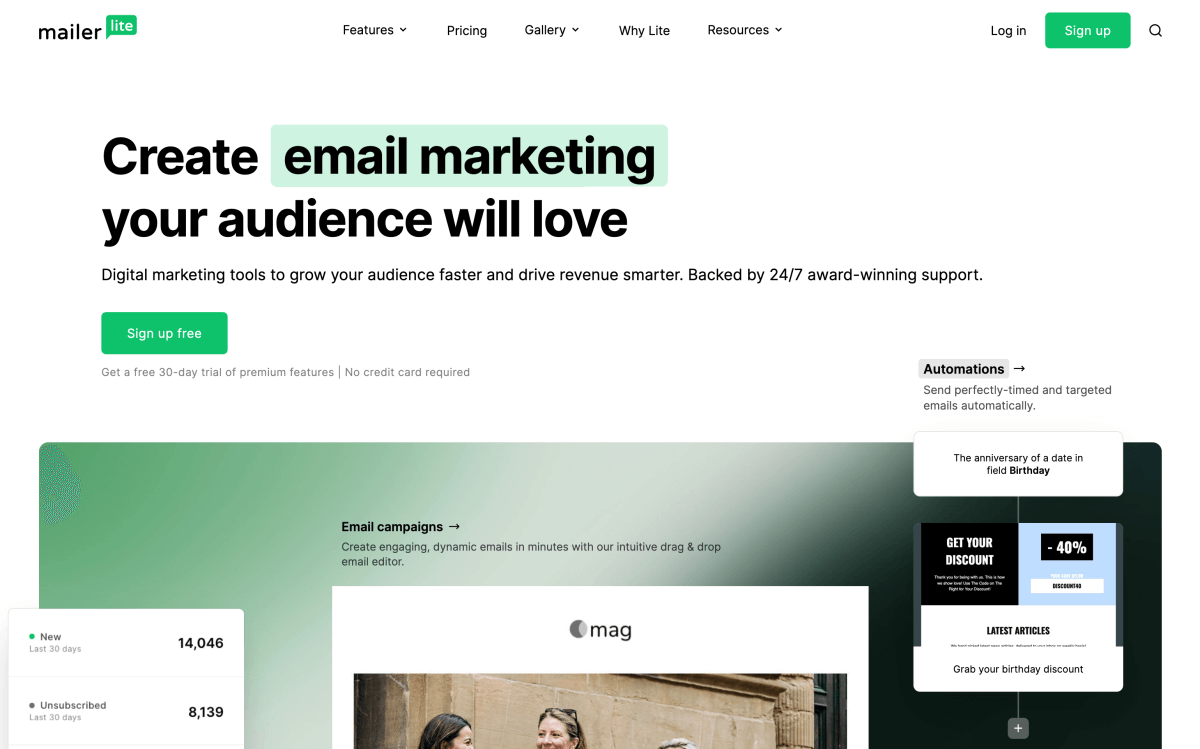
Quick tips:
- Slice and dice your email list by segmenting your subscribers according to interests. Then, set up laser-targeted promotion campaigns and automated email sequences and courses.
- Craft irresistible subject lines to make sure your subscribers open your emails. that pull your readers in.
- Establish common ground – share your personal experience with your affiliate product.
- Make those CTAs (Call-to-actions) as engaging as a chest of hidden pirate treasure.
3. Create a free email course
Now that you’ve created your email list, it’s time to deliver value to your subscribers. I’m a huge fan of automated email courses that teach the basics of a specific topic.
Email courses are easy to set up and they will do all the hard work for you. All you need to do is:
- Figure out what your audience struggles with
- Find an affiliate product that solves their problem
- Plan 4 to 7 emails where you help your subscribers overcome their struggle
- Present your affiliate product towards the end of your course
To see what I mean, join my 7-day email course to start a profitable blog below:
Hence, email courses are magnets for those hungry for knowledge. Creating a helpful email course is your chance to enlighten your audience with wisdom based on your personal experience with your affiliate product.
It’s a gradual journey where you nurture your audience and introduce affiliate products at the perfect moment. Email courses build trust and authority in your niche, which translates into affiliate income over time.
Practical example:
If you have experience in digital marketing and know your way around Instagram, you should create a free email course on how to get more followers. As your subscribers progress through your lessons, introduce them to the best social media management tool with your affiliate link.
Quick tips:
- Design a well-structured, value-packed email course. Your affiliate product must solve a specific problem for your subscribers.
- Gradually introduce affiliate products at points where they can truly benefit your audience.
- Use enticing subject lines to ensure high open rates.
- Measure engagement and continuously optimize the course for better results. Ask your subscribers for feedback!
4. Include affiliate links in your video content
Video content isn’t just a trend; it’s a tidal wave of affiliate earnings waiting to be surfed. In fact, YouTube is the 2nd most visited website worldwide, with 2.7 billion monthly active users.
The best part?
You can create videos about anything you want. But again, you want to know exactly what your target audience struggles with. That way, you can create the perfect video content to solve their problems.
And since we’re talking about the best ways to promote affiliate links, you need to find the right products that your audience needs.
Pick a user-friendly video editing tool like InVideo to create professional video content easily. InVideo now offers a powerful AI-based video creation tool that even generates voiceovers – definitely worth checking out.
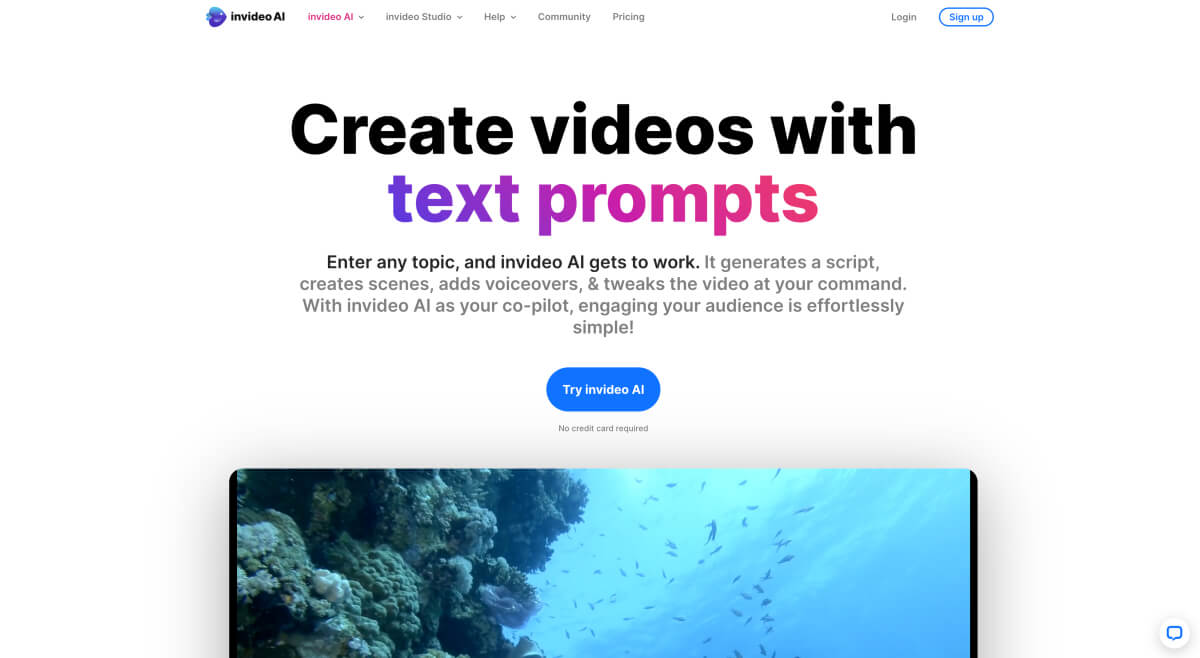
Video content is perfect for product demonstrations and reviews. Especially if you want to create step-by-step tutorials, creating a video is so much easier than writing a blog post about it.
Also, video content works really well for beauty and skincare products, for example.
Just make sure to place your affiliate links in the video description.
You can create a short and professional video within minutes using web-based video editors like InVideo (in fact, InVideo is probably the most affordable solution I’m aware of)
Practical example:
Let’s say you’re a tech enthusiast and you love gadgets. Setting up a YouTube channel and creating product reviews would be a fantastic way to promote your affiliate products. In your video description, include affiliate links to the products you discuss, and they’ll fly off the shelves.
Quick tips:
- Optimize your video titles, descriptions, and tags for search.
- Make your affiliate links easily accessible in the video description.
- Engage with comments and build a community around your content.
- As your channel grows, invest in high-quality video and audio equipment to ensure a professional look and sound.
5. Send Pinterest traffic to your affiliate links
Pinterest is the biggest visual search engine worldwide with over 400 million monthly users. It isn’t just a place for recipe and DIY enthusiasts – you can establish a presence in any niche you can imagine on Pinterest.
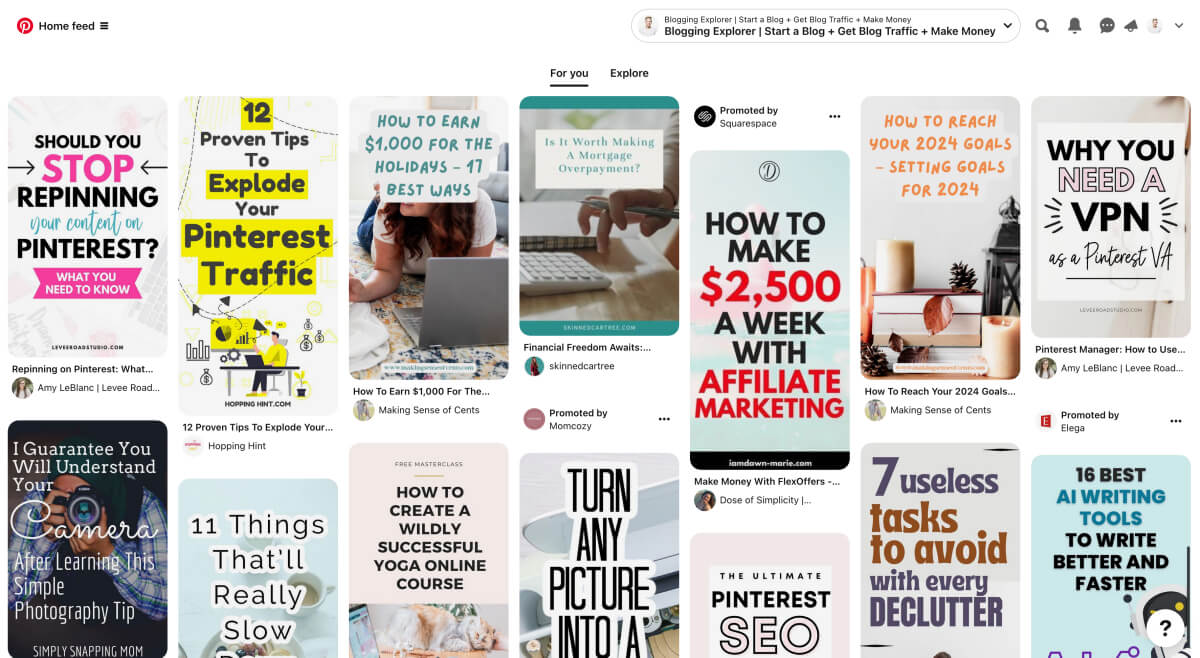
Hence, if you’re looking for the best way to promote affiliate links, now is the perfect time to add Pinterest to your marketing toolkit.
The best part is: Pinterest users are constantly looking for new ideas and inspiration. As long as you understand what your audience is searching for, you can create targeted content and share it on the platform to drive users to your affiliate links.
If you aren’t familiar, check out my Pinterest marketing strategy guide to drive tons of free traffic to your affiliate content.
Practical example:
Let’s say you’re a fashion enthusiast. On Pinterest, you can create stunning boards showcasing beautiful outfits, accessories, and styling tutorials. In your pin descriptions, you can include affiliate links to help users put together the perfect look for them with just a few clicks.
To get started, read my full Pinterest affiliate marketing guide.
Quick tips:
- Set up a free Pinterest business account.
- Find the right Pinterest keywords for your topic.
- Create and optimize at least 10 to 15 Pinterest boards.
- Design visually appealing viral pins that stand out on Pinterest.
- Craft compelling pin descriptions that spark curiosity and interest.
- Ensure your affiliate links are appropriately disclosed.
If you’re serious about beating your competition and becoming an affiliate superstar in your niche, don’t miss my popular Pinterest SEO ebook.
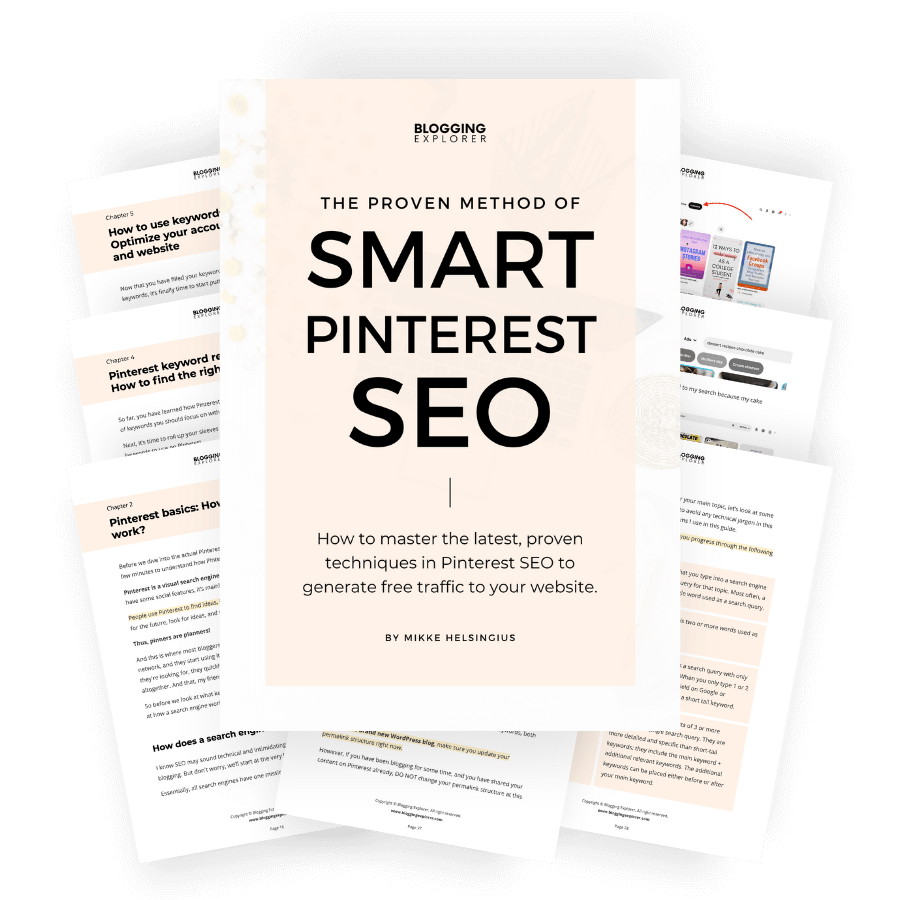
6. Share affiliate links on social media
In 2023, an estimated 4.9 billion people use social media across the world. Moreover, this number is expected to jump to approximately 5.85 billion users by 2027.
However, the biggest problem is to know where and how to reach your target audience on social media. You don’t want to waste your time on networks that are irrelevant to your potential readers, right?
With dozens of platforms out there, which networks should you focus on?
Again, start by identifying your target audience. Find out where they hang out and spend their time online.
Create a profile on 1-3 relevant social networks at this point. You want to secure a username that matches your blog or website URL, for instance.
With strategic posts and engaging captions, you can direct followers to your affiliate products that align with their interests. Social media provides a real-time platform for personal interaction and engagement with your audience.
Practical example:
Create the type of content you feel comfortable with, whether it’s video, photos, or long-form content.
For example, if you’re a fitness enthusiast, start building a strong social media presence asap. Create posts highlighting the benefits of a particular product, regime, supplement, for example.
Remember to include your affiliate links for your followers to discover what you’re promoting.
To gain momentum, follow a consistent publishing schedule and be strategic about it. Plan your content ahead, focus on one topic at a time, and make sure to connect with your audience.
Quick tips:
- Choose the social platforms that resonate most with your niche and audience.
- Engage with your audience through comments and messages.
- Use relevant hashtags to extend your reach to new potential customers.
- Maintain a balance between promotional and non-promotional content to keep your audience engaged.
7. Create gift guides and product roundups
Gift guides and product roundups are the perfect vessels to promote affiliate links and product recommendations in a way that’s helpful and enticing.
Especially gift guides can be an affiliate goldmine during the holiday season. Shoppers are seeking perfect present ideas for partners, parents, kids, colleagues – everyone.
Since they’re actively looking to purchase something, gift guides usually generate above-average conversion rates.
Your job is to present them with a selection of hand-picked ideas where they can compare a few alternatives.
Practical example:
Imagine you’re a tech aficionado, and you’ve created a “Best iPhone Gadgets for 2024” guide, complete with detailed product descriptions and affiliate links. A detailed gift guide or product roundup makes it easy for readers to find what they’re looking for.
Quick tips:
- Thoroughly research and curate products that align with your audience’s interests.
- Target a specific demographic, such as kids, wives, husbands, parents, neighbors, or friends.
- Craft engaging and informative descriptions for each product.
- Include affiliate links prominently, and clearly disclose your affiliate relationships.
- Regularly update your guides to feature current and popular products.
8. Add affiliate links to your digital products
If you’re selling digital products, you’re already in the affiliate marketing game. Why not supercharge your earnings by including more affiliate links?
Digital products are an excellent way to earn passive income. But they pair perfectly with affiliate marketing, too.
For example, if you’re selling ebooks through SendOwl or Gumroad, you can include links to your affiliate products within your PDF ebooks.
Since digital products cater to a specific niche, it’s easy to find matching products that cater to your customers’ needs.
Plus, since your customers have already purchased your product, it’s a sign that they trust you. Therefore, they’re more likely to follow your recommendations for further, valuable resources.
However, don’t just spam your entire affiliate product portfolio into your digital product. Only promote affiliate links that are relevant and complementary to your own product.
For example, in my Viral Pinterest Template Pack for Canva, I’ve included an entire directory of my recommended tools for making the most of the templates, such as:
- Stock photo sites
- WordPress tools
- Design tools
- etc.
Practical example:
Let’s say you’ve published an e-book on fitness and healthy living. Within the e-book, you can embed affiliate links to fitness equipment, supplements, and meal planning services. All of those products enhance and boost the value of your ebook and guide your readers towards additional, truly valuable resources.
Quick tips:
- Ensure your digital products are highly relevant to your affiliate recommendations.
- Embed affiliate links naturally within your product content, so they don’t disrupt the user experience.
- Include clear and prominent disclosure about your affiliate relationships.
- Regularly update your digital products to keep them fresh and in line with your current recommendations.
9. Set up a resources page
A resources page on your website is like an affiliate oasis for your audience, where they can find the solutions they seek.
For example, my Best Blogging Resources page is one of my most visited URLs on this website. Since Blogging Explorer is all about helping you guys find the best tools for starting, growing, and monetizing your blogs, my resources page is like an all-in-one directory of everything you need.
Your resources page will help your audience discover the products and solutions you’ve used to achieve the results that they are striving for, too. A well-structured resources page simplifies the research and decision-making process, saving your followers heaps of time.
If you’ve written detailed reviews about individual resources and tools, remember to share links to those on your resources page, too.
Practical example:
If you’re a travel blogger, create a resources page with affiliate links to the best travel gear, booking platforms, and even language-learning courses.
Quick tips:
- Organize your resources page neatly, categorizing your affiliate products for easy navigation.
- Include a clear affiliate disclosure at the top of the page for transparency.
- Provide brief but informative descriptions for each recommended product or service.
- Regularly update your resources page to add new tools and remove outdated ones.
10. Share affiliate links in a webinar
Webinars are not just informative sessions; they’re live stages for promoting affiliate links and targeted products.
You can create a webinar about any topic you like, but make sure you address a specific problem your audience needs help with.
Keep it simple and focus on a single issue or topic. Answer frequently asked questions, address common concernss, and introduce affiliate products seamlessly during the webinar.
All in all, webinars are a fantastic way to build trust with your followers. It’s the closest you can get to offering 1-on-1 sessions to help your audience reach their goals faster.
Here are a few popular platforms to check out:
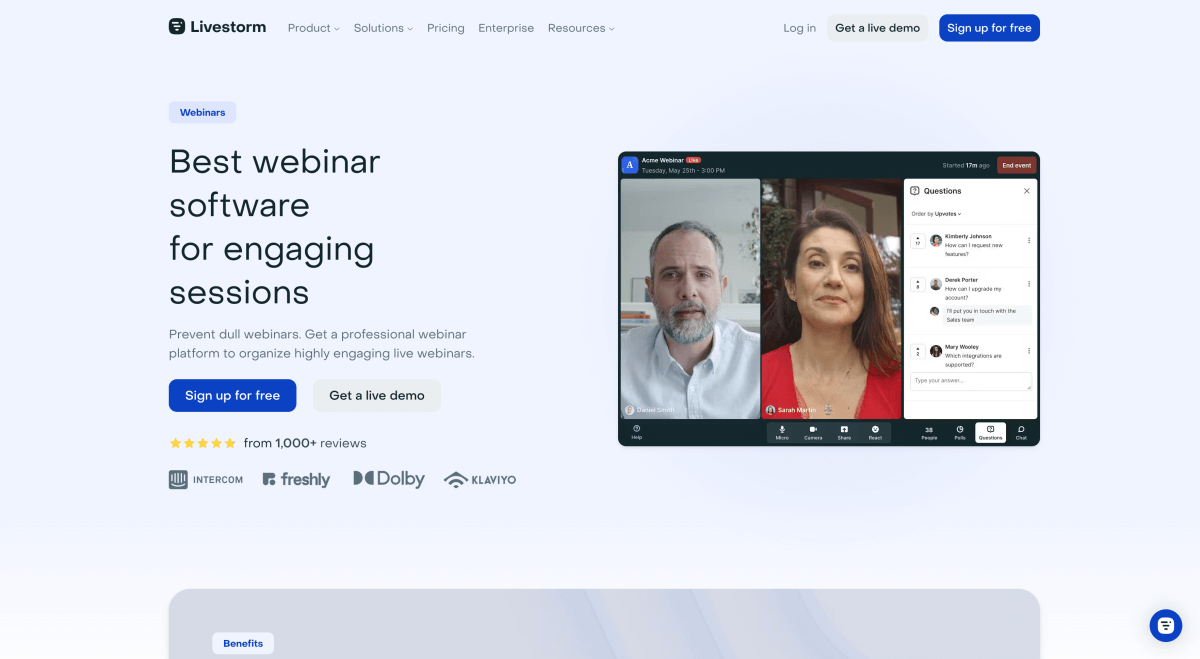
Practical example:
If you’re a cryptocurrency expert, host a webinar on smart investment strategies for beginners. Help your audience make educated decisions when investing in Bitcoin, for example.
As with all financial advice, remember to highlight your disclaimer and be honest about your level of experience and the results you’ve achieved.
You must be 100% transparent about the fact that the results you’ve achieved don’t necessarily reflect the outcome your audience will get by following your advice.
Throughout the session, you can introduce affiliate links to investment platforms and tools that can help your audience grow their wealth.
Quick tips:
- Carefully plan your webinar with a structured agenda.
- Actively engage with your audience during the event to build rapport.
- Demonstrate how the affiliate products directly solve a problem or enhance the webinar’s topic.
- Offer exclusive discounts or bonuses to webinar attendees who make purchases through your affiliate links.
11. Insert affiliate links to a SlideShare presentation
SlideShare if a platform where you can publish presentations and educate your audience about a complex topic in bite-sized lessons.
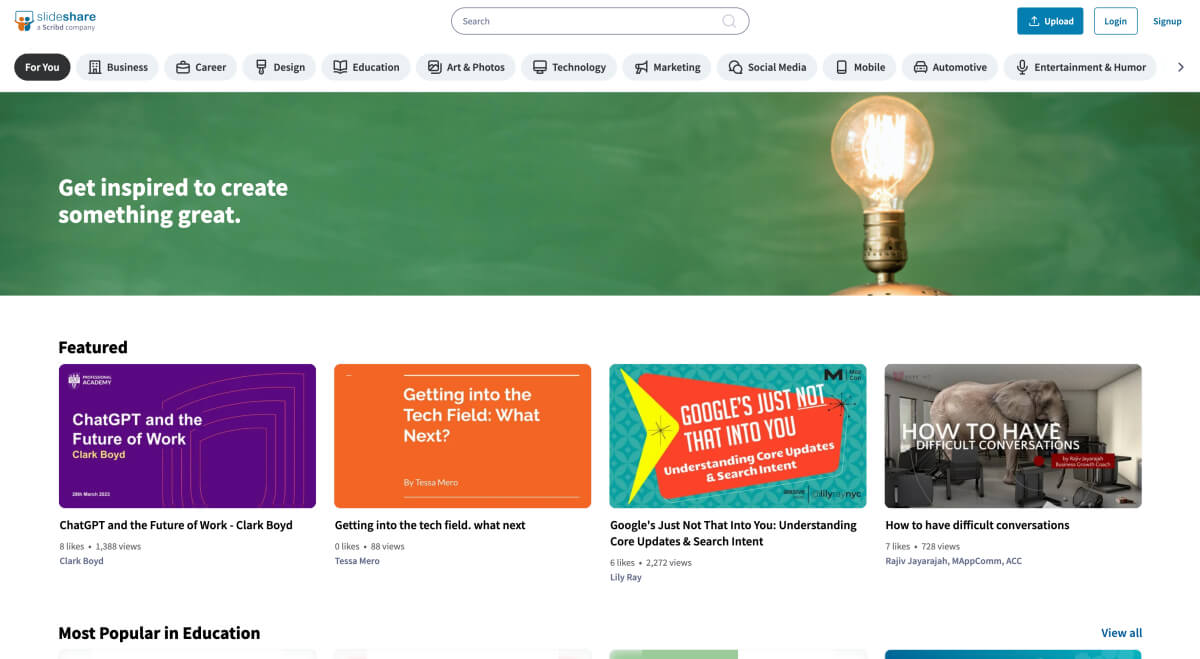
Slide presentations are a great way to break down larger topics into easy-to-digest slides. And you can further emphasize your message with visual elements like graphs and charts.
Since your audience is actively seeking information on SlideShare, you should start building presentations that help them achieve what they’re looking for asap. Creating a thorough, step-by-step presentation is a fantastic way to promote your affiliate links, too.
Practical example:
If you’re a cooking enthusiast, create a SlideShare presentation on “Must-Have Kitchen Gadgets for Busy People”. Feature a helpful, time-saving cooking or baking gadget on each slide. Remember to embed your affiliate links to each product.
It’s a win-win: your audience is now ready to cook up a storm with their new tools, and you’ll generate affiliate revenue that ramps up over time.
Quick tips:
- Design visually appealing slides that complement your content.
- Ensure your affiliate disclosures are clear and upfront.
- Include affiliate links as part of your slides, making them easily accessible.
- Share your SlideShare presentation on multiple platforms to help people find it.
12. Share affiliate links in an online course
Online courses are one of the best ways to promote affiliate links and earn passive income right now. They allow you to create dynamic, evergreen learning paths for your target audience, helping them achieve a certain outcome step-by-step.
Popular platforms include:
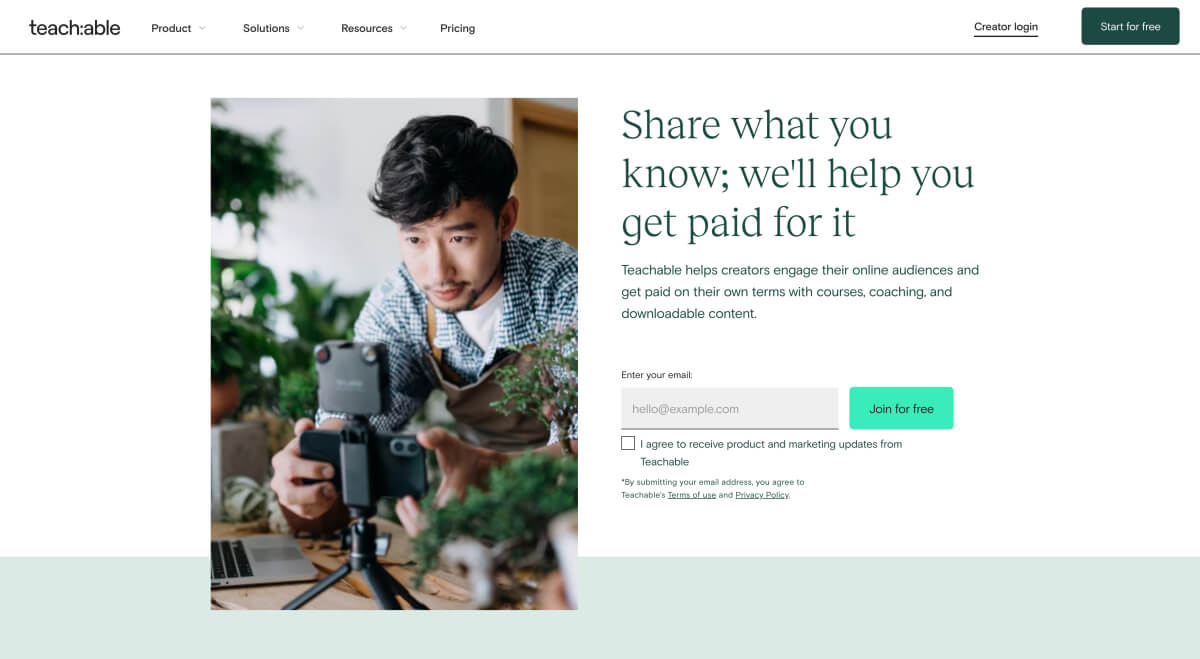
Since you’re sharing your knowledge and expertise on a specific topic in each course, you’re automatically building trust with your students. That said, make sure you are 100% honest about your background and showcase your skills and experience like a pro.
You can then seamlessly introduce your affiliate products throughout the course curriculum. Moreover, you can embed affiliate links into your course materials, discussions, and emails, too.
Practical example:
If you are a digital marketing expert, you can create an online course on “Digital Marketing Mastery for Female Influencers”, for example. Help beginners conquer the saturated world of influencer by sharing your best strategies for generating followers and building an authority.
Throughout the course, introduce affiliate products, such as marketing tools and software, that can accelerate your students’ success.
Quick tips:
- Ensure your affiliate recommendations are directly related to your students’ needs and goals.
- Seamlessly integrate affiliate links into your course materials and discussions.
- Make it clear to your students that these recommendations can speed up their progress.
- Offer exclusive discounts or bonuses to course students who make purchases through your affiliate links.
13. Promote your affiliate site on discussion forums
General or niche-specific online forums and communities are goldmines for affiliate marketers. Since people are actively searching for helpful tips and information, you can share your best tips and lessons to an audience who’s already interested in what you have to say.
But remember: discussion forums aren’t about spamming your affiliate links in every thread you can find. Instead, you need to build trust and deliver real value before you can subtly mention a detailed product review on your blog website, for example.
Hence, be extra careful about how you come across on forums like:

If done right, discussion forum marketing is a fantastic way to capture your ideal followers and helping them with the right affiliate products.
But again, it all boils down to genuinely helping your target audience by sharing everything you know before you can expect to see commissions rolling in.
Practical example:
If you’ve started a blog and published thorough, helpful articles on Pinterest marketing, for example, share your best tips on Quora.
Find relevant boards and threads where people ask questions about topics like social media marketing or Pinterest marketing tips for small businesses.
Start by answering relevant questions with your best tips. If a specific article on your blog includes further tips and strategies that deliver even more value, you can share a link to it. That way, you won’t come across as a spammer since you’ve already shared helpful points in your answer.
If people are interested in learning more about the topic, they can visit your blog post where you’ll want to embed affiliate links to relevant products.
Quick tips:
- Build a reputation as a helpful, knowledgeable member.
- Avoid sharing your affiliate links in your answers – instead, share a link to a helpful blog article you’ve written, with embedded affiliate links about that particular topic.
- Focus on offering value, help, and solutions to questions related to your niche.
- Steer clear of obvious self-promotion.
14. Use paid advertising to scale your marketing
If you’re ready to invest a few bucks to speed up your growth, paid advertising can turbocharge your affiliate marketing game.
If cone correctly, paid advertising means that you’ll spend money to earn it back through affiliate commissions.
Paid ads guarantee visibility and can drive almost immediate results. Plus, they allow you to reach a highly targeted audience who’s actively searching for the type of content you publish.
Of course, you have to know your expected conversion rates so that you can calculate how much money you can spend on your ad campaign.
Therefore, driving traffic to your affiliate links with paid ads is an advanced strategy to promote affiliate links.
If you are just getting started, I recommend growing your traffic organically at first. Learn about your audience, be mindful of what type of content generates conversions, and improve your game before investing in paid ads.
Practical example:
If you’ve created an awesome blog post that generates a good amount of affiliate conversions and commissions, consider running a Facebook or Google Ads campaign to drive even more traffic to your content.
Make sure you narrow down your audience carefully using demographics and keywords wisely.
Start with a small ad budget and track the results closely to see whether your campaign needs further adjustments.
Quick tips:
- Set a budget and test your ads to find what works best.
- Use compelling ad copy and visuals.
- Monitor ad performance and make adjustments.
- Ensure your landing page is optimized for conversions.
What should you do next? 4 smart affiliate marketing tips
You’re ready to set sail on your journey to boost your affiliate income by using the best ways to promote affiliate links above.
Before you start tweaking your strategy, here are four smart affiliate marketing tips to guide you along the way:
1: Create stellar, share-worthy content
In the online world of affiliate marketing, content is your currency. You can’t expect to publish sub-par content – there’s just too much content out there already. Hence, if you want to generate affiliate income, your content must stand out.
It’s all about educating and entertaining your audience, but also compelling them to take action. The only way to achieve that is to know their problems and questions. Otherwise, you can’t publish content that makes their lives easier.
Here are my best guides for creating amazing content:
- 14 Quick Ways to Find Blog Post Ideas for Writers
- How to Write a Great Blog Post (Every Time): The Ultimate Guide
- 6 Time-Saving Tips to Write Blog Posts Faster
Remember: each blog post, Pinterest pin, Instagram post, and YouTube video needs to address one specific question. Your followers are actively looking for solutions, so all you need to do is deliver bite-sized solutions to them.
The easiest way to create share-worthy content is to share your personal stories, insights and recommendations with your audience. As you continue to create high-quality, valuable content, your audience will grow, and so will your affiliate income.
2: Learn SEO
Search Engine Optimization (SEO) is the wind in your affiliate marketing sails. It’s the art and science of making your content discoverable and attractive to search engines.
With the right SEO techniques, your content can rise to the top of search engine rankings, leading more visitors to your affiliate links. Therefore, invest time in learning the basics of SEO, from keyword research to on-page and off-page optimization.
Keep up with the latest SEO trends to stay ahead of the competition and make the most of your affiliate marketing efforts.
3: Stay persistent and patient
Rome wasn’t built in a day, and neither are thriving affiliate marketing businesses. Success requires patience and persistence.
You might not see immediate results, but don’t be discouraged. Keep publishing valuable content, engaging with your audience, and refining your strategies.
Rome also wasn’t built by one person alone, so build relationships with your audience, fellow marketers, and affiliate programs. With time, your efforts will compound, and your affiliate income will steadily grow.
4: Keep learning and improving
Affiliate marketing is a dynamic field that’s always evolving. To stay ahead, you must be willing to learn and adapt.
Invest time in expanding your knowledge about your niche, marketing trends, and affiliate programs. Attend webinars, conferences, and online courses to gain insights and skills.
Don’t shy away from experimenting with new methods and techniques. By continually learning and improving your strategies, you’ll keep your affiliate marketing efforts fresh and effective.
If you’re serious about getting started, grab your copy of my Affiliate Marketing Profits for Bloggers guide. It’s your all-in-one package for working smarter (not harder) to build a profitable affiliate marketing business in any niche.
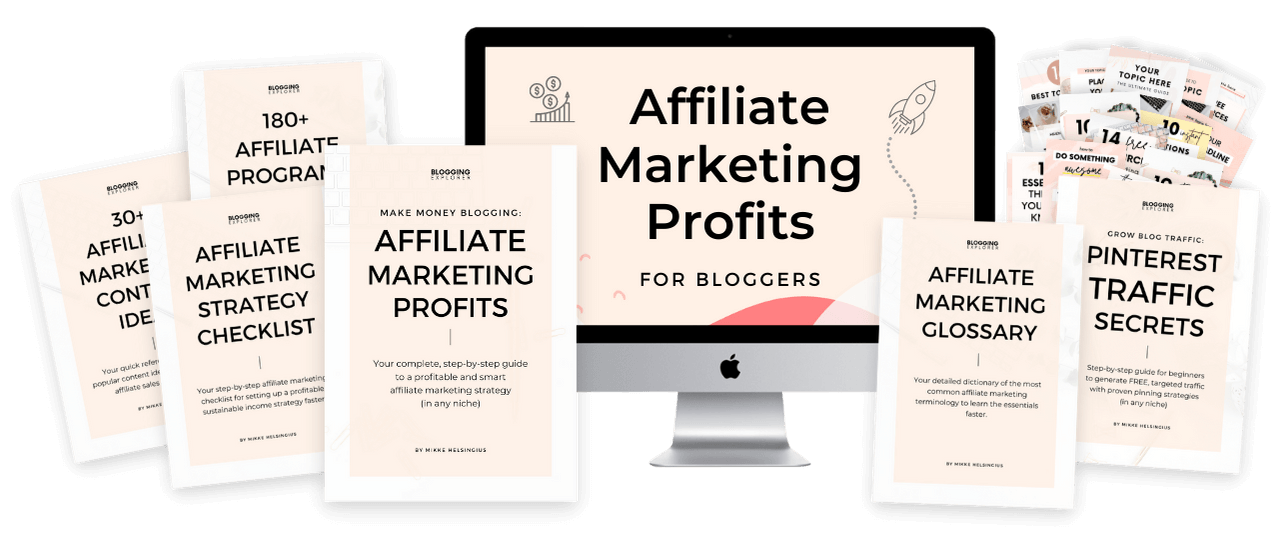
FAQ: Best way to promote affiliate links
Look for programs that align with your niche, offer competitive commissions, provide quality products, and have a good track record of timely payments. Sign up with an affiliate network like ShareASale, Awin, ClickBank, CJ Affiliate, or Rakuten Advertising to browse programs in your niche. If you’re not sure where to start, Amazon Affiliates allows you to promote any product sold on Amazon.
Yes, you can, but make sure it’s relevant and doesn’t overwhelm your audience. Focus on delivering real value through genuinely helpful content. Complement it with affiliate products that help your audience achieve their goals faster.
Always disclose your affiliate relationships clearly and conspicuously. Use a clear phrase like “This post contains affiliate links” and link to your full affiliate disclaimer at the beginning of your content.
Most affiliate programs provide dashboards with detailed statistics. You can also use tools like Google Analytics to track link performance.
It depends on your niche and audience. Some niches prefer physical products, while others favor digital ones. Start by figuring out who your target audience are and be mindful of what they need.
Yes. If you haven’t used a product yourself, it’s difficult to build trust with your audience. Hence, unless you’re a Kardashian, always get to know your affiliate products before recommending them to others.
Final thoughts
If you are serious about earning passive income through affiliate marketing, knowing the best ways to promote affiliate links is absolutely essential.
Remember: there are tons of people out there who need what you are promoting, but your presentation is what matters the most.
You will get fantastic results when you have tried and you truly understand what you are promoting. Hence, don’t just go about spamming your link everywhere. Instead, understand what your target audience struggles with, and offer them the perfect solution to their problem.
Follow my strategies above and people will start flocking to you. And that’s when you’ll start seeing those affiliate commissions roll in.
Related guides to learn more about making money online:
- How to Make Money Blogging for Beginners: Step-by-Step Guide
- 15 Reasons Why Your Blog Isn’t Making Money (And How To Fix Them)
- 11 Popular Blog Ideas That Make Money
- How to Make Money With Ads on Your Blog: The Ultimate Guide
If you found this post helpful, share it with others!

